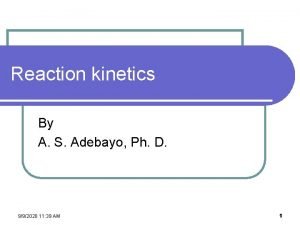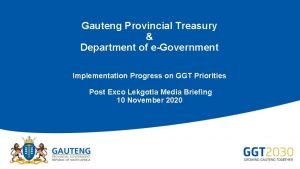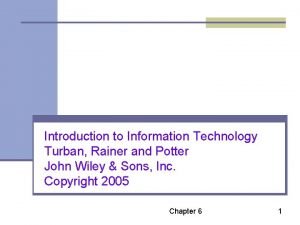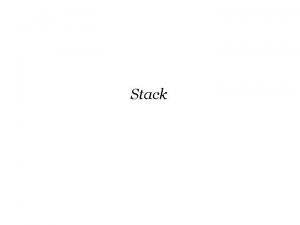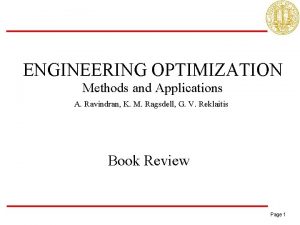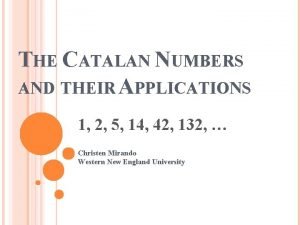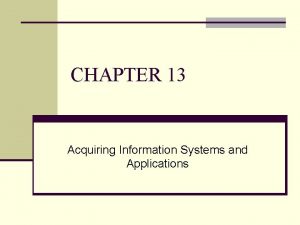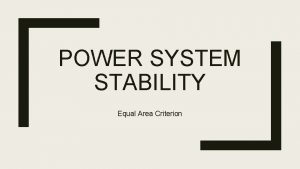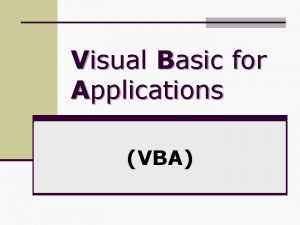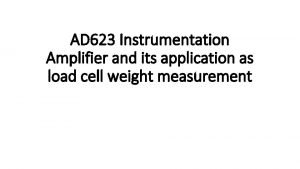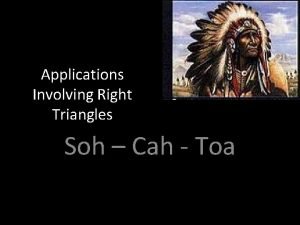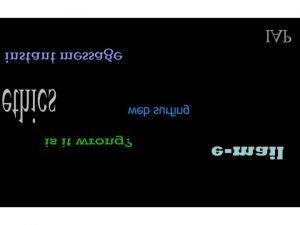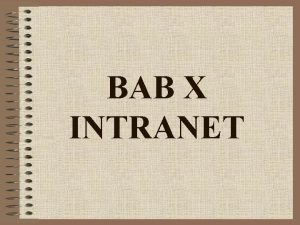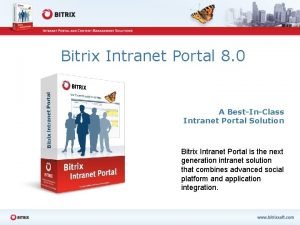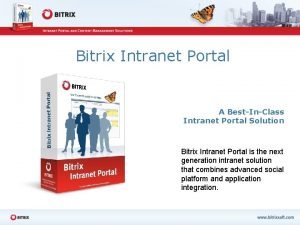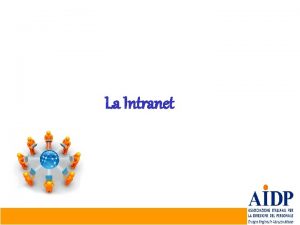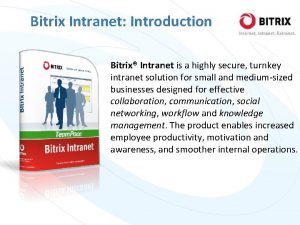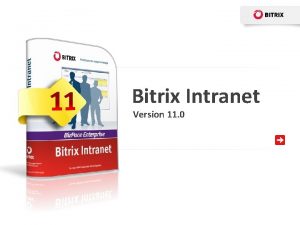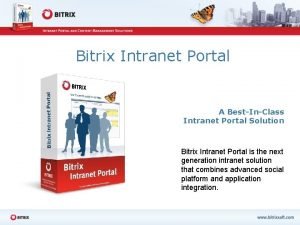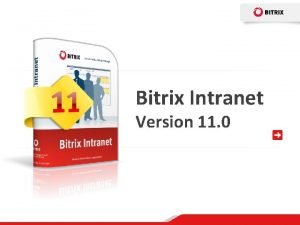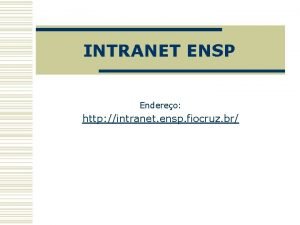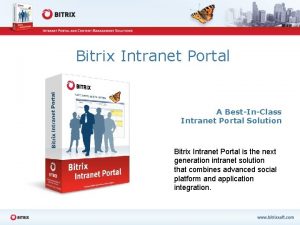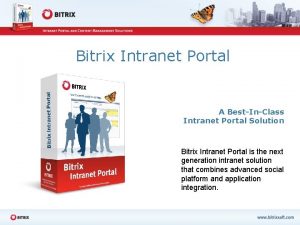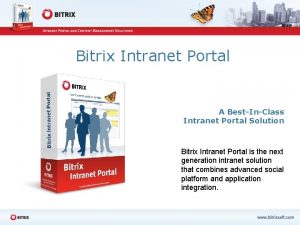Evaluation of applications over an intranet 1 Intranet






















- Slides: 22

Evaluation of applications over an intranet 1

Intranet architecture 50 Unix Workstation File server 2 Lan 2 10 Mbps Eth Lan 3 10 Mbps Eth R 2 File server 1 120 Windows NT clients Web server R 1 FDDI 100 Mbps Lan 5 100 Windows NT clients R 3 File server 3 Lan 1 10 Mbps Eth R 4 File server 4 Lan 4 16 Mbps TR 100 Windows NT clients 2

Workload analysis Intranet applications (there different classes): 1) Corporate training: web based applicatin 2) Access to local file system 3

Infrastructure hypothesis • All file server and web server have a single CPU and a single disk • The FDDI and the router are very fast versus the Lan Ethernet, then can be modelled as a simple delay, therefore they are server without queue • All the other components can be modelled as queues with service time independent by the load. 4

User hypotheses • • Finite number of users An user generates a new request, after having received an answer to the previous request, after a time equal to its thinking time 85% of users is working with the local file system 15% of users is working with the Web Server 5

Queueing network Multiclass closed queue model, each class is charaterized by: client group, application, server • • client group: CLi: clients in Lan i (i: 1 to 4) application: – FS for local file server access, – TR for Training • server: – FSi: i-th NFS server (i: 1 to 4) – Web. S: Web Server 6

Tipi di classi e numero di utenti (CL 1, FS 1) (CL 2, FS 2) (CL 3, FS 3) (CL 4, FS 4) (CL 1, TR, Web. S) (CL 2, TR, Web. S) (CL 3, TR, Web. S) (CL 4, TR, Web. S) 120 x 0. 85 = 102 50 X 0. 85 = 43 100 x 0. 85 = 85 120 x 0. 15 = 18 50 x 0, 15 = 7 100 x 0, 15 = 15 7

Server types Routers: low delay, given its low latency FDDI ring: low delay, given high bandwidth CPU Disks LANs servers with load independ service time Service Demands: Di, r = Vi, r x Si, r where Vi, r = Visit Ratio Si, r= Service Time 8

QN model (CL 1, FS, Fs 1) (CL 2, TR, Web) (CL 2, FS, Fs 2) (CL 1, FS, Fs 1) D D L 2 C C R 2 L 1 R 1 FDDI D (CL 1, Tr, Web) (CL 2, Tr, Web) (CL 4, Tr, Web) R 3 C (CL 3, FS, Fs 3) L 3 R 4 (CL 1, TR, Web) (CL 2, TR, Web) (CL 3, TR, Web) (CL 4, TR, Web) C Web S D 9 (CL 3, TR, Web)

Web server workload characterization (for a training session) • Avg request document size per HTTP request – 20 rqs for txt documents (2. 000 bytes per doc) – 100 rqs for inline images (50. 000 bytes each) • (20 text pages x 5 inline/text pages) – 15 rqs for other multi-media (mm) obj (2. 000 bytes each) 10

Web server workload characterization • % request for: – txt documents = 20/(20+100+15) = 15 % – inline images = 100/(20+100+15) = 74 % – other mm obj = 15/(20+100+15) = 11 % 11

Web server workload characterization • Average document size 0. 15 x 2. 000 + 0. 74 x 50. 000 + 0. 11 x 2. 000 = = 257. 300 bytes Note it is an average, the overhead associated to the three document sizes is different 12

Web server workload characterization • Document request arrival rate is function of the think time and of the number of users in the system (CLi, TR, Web) Max # 18 per Lan 1 7 per Lan 2 Usersi 15 per Lan 3 15 per Lan 4 #Usersi think time 45 sec 13

Web server workload characterization • Device service time – CPU: 1 msec processing time x HTTP request – Disk: We need to consider • Seekrand= avg time to position at a random cylinder • Disk. Rev. TIme = time for a complete disk revolution • Transfer. Time = Block. Size/ 106 x Transfer. Rate • Controller. Time = time spent at the controller for an I/O req. Sd = Controller. Time +Pmiss x (Seek. Rand + Disk. Revolution. Time/2+Transfer. Time) 14

Web server workload characterization • Lan hp: no fragmentation i. e. max data area 1500 bytes; hp no data overhead for HTTP request NDatagrams = Message. Size + TCPOvhd minn MTUn - IPOvhd Overheadn = TCPOvhd+Ndatagrams x (IPOvhd + Frame. Ovhdn) Service. Timen = 8 x (Message. Size + Overheadn ) 106 x Bandwidth 15

Web server workload characterization • Lan hp: no fragmentation i. e. max data area 1500 bytes; hp no data overhead for HTTP request • Ethernet NDatagrams = 257300 + 20 1500 - 20 Overheadn = 20 + Ndatagrams x (20 + 18) Service. Timen = 8 x (257300 + 18 ) 106 x Bandwidth 16

Web server workload characterization • Lan hp: no fragmentation i. e. max data area 1500 bytes; hp no data overhead for HTTP request • Token ring NDatagrams = 257300 + 20 1500 - 20 Overheadn = 20 + Ndatagrams x (20 + 28) Service. Timen = 8 x (257300 + 28 ) 106 x Bandwidth 17

Web server workload characterization • Router • delay 134 msec x packet (approximated in total to 1 msec) • FDDI • delay with Service. Timen = 8 x (Message. Size + Overheadn ) 106 x Bandwidth 18

Local file system workload characterization • File dimension 8192 bytes • avg NFS request arrival rate is function of the think time and number od users in the system #Usersi (CLi, FSi) think time 10 sec Max #Usersi 102 per Lan 1 43 per Lan 2 85 per Lan 3 85 per Lan 4 19

Local file system workload characterization • Device service time – CPU: 1 msec per file request – Disk: We need to consider • Seekrand= avg time to position at a random cylinder • Disk. Rev. TIme = time for a complete disk revolution • Transfer. Time = Block. Size/ 106 x Transfer. Rate • Controller. Time = time spent at the controller for an I/O req. • N blocks to read = 8192/2048 = 4 – Lan i with 8192 bytes 20

Throughput & response time Class Throughput (req/sec) • • CL 1, FS 1 CL 2, FS 2 CL 3, FS 3 CL 4, FS 4 CL 1, TR, Web. S CL 2, TR, Web. S CL 3, TR, Web. S CL 4, TR, Web. S 10, 12 4, 23 8, 44 0, 34 0, 14 0, 28 Response time (sec) 0, 08 0, 06 0, 08 0, 07 8, 58 8, 55 7, 96 8, 35 21

Throughput & response time Throughput = Max#Usersi response time + think time 22
 Means right evaluation
Means right evaluation Understanding harmony in the family
Understanding harmony in the family Handing over and taking over the watch
Handing over and taking over the watch Over the mountain over the plains
Over the mountain over the plains Siach reciting the word over and over
Siach reciting the word over and over Https //parkright.westminster.gov.uk/permit applications
Https //parkright.westminster.gov.uk/permit applications Applications of chemical kinetics
Applications of chemical kinetics Kcvs.ca photoelectric effect
Kcvs.ca photoelectric effect Ggt2030 application form
Ggt2030 application form Intrabusiness applications
Intrabusiness applications Stack adt
Stack adt Recombinant dna technology applications
Recombinant dna technology applications Technology applications middle school lessons
Technology applications middle school lessons Balaraman ravindran
Balaraman ravindran Difference between occlusion and mixed-crystal formation
Difference between occlusion and mixed-crystal formation Catalan numbers recursive formula
Catalan numbers recursive formula Application of fractional distillation
Application of fractional distillation Methods of acquiring information system
Methods of acquiring information system Explain equal area criterion
Explain equal area criterion Visual basic for applications
Visual basic for applications Ad623
Ad623 Applications involving right triangles
Applications involving right triangles Chris quintin
Chris quintin






